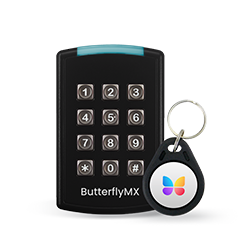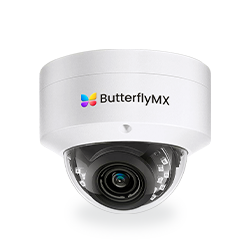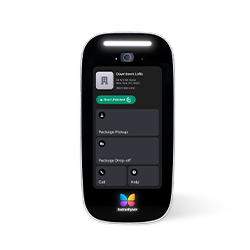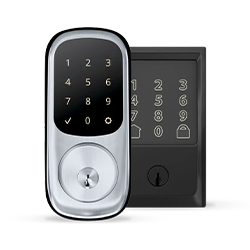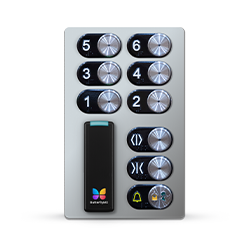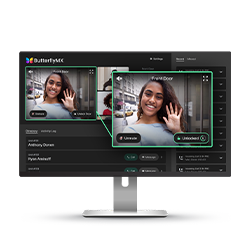Key takeaways
- Location based access control (LBAC) uses geolocation data to grant or restrict access, adding a powerful layer of security beyond traditional methods.
- Pairing LBAC with geofencing creates seamless, automated access experiences while maintaining strict security boundaries.
- Common use cases range from securing office buildings and gated communities to protecting cloud applications and temporary event spaces.
- Successful implementation requires accurate location data, clear policies, and integration with existing access control systems.

As security threats become more sophisticated, organizations are looking for ways to strengthen access control without adding unnecessary friction for authorized users. Location based access control (LBAC) offers a powerful solution by using geolocation data to verify where a person is before granting access to a building, system, or application.
When paired with geofencing technology (virtual boundaries that trigger specific actions), LBAC can create a seamless yet highly secure experience, ensuring only the right people in the right place at the right time can gain entry.
In this guide, we’ll break down how LBAC works, its benefits, real-world use cases, and how it compares to other access control system models, so you can determine whether it’s the right fit for your security strategy.
Navigate this guide:
- What is location based access control?
- How location based access control works
- Benefits of location based access control
- Use cases for location based access control
- Location based access control vs other access control models
- Challenges and considerations of LBAC
- How to implement location based access control
- The future of LBAC and geofencing security
- Location based access control FAQs
More than 40K, 5-star reviews!

Video Intercoms
Open doors, gates & garages from anywhere.

QR Code Intercom
Smartphone-based visitor access.
Access Control
Fob, key cards, PINs, and mobile apps.
Security Cameras
Visibility throughout your property.
Vehicle Access
Hands-free access for gates & garages.
Package Room
Receive, store, and manage deliveries.
Smart Locks
Connect to all major brands and models.
Elevator Controls
Unlock key-fobbed elevators for anyone.
Front Desk Station
See all your doors and cameras in one place.
What is location based access control?
Location based access control (LBAC) is a security method that uses a person’s physical or network location to determine whether they’re allowed to access a building, system, or resource. Instead of relying solely on a password, key card, or biometric credential, LBAC adds a location check, granting access only if the user is in an approved area or connected through an authorized network.
This approach works by verifying geolocation information, which can be gathered from GPS coordinates, WiFi networks, cellular data, or even IP addresses. For example, a company might allow employees to log in to sensitive applications only when they’re on-site at the office or within a predefined geographic boundary. Similarly, a gated community could integrate LBAC with its entry system to ensure residents and approved guests can only enter while physically near the property.
By tying access permissions to location, LBAC reduces the risk of unauthorized logins from untrusted networks and helps organizations meet strict security and compliance requirements.
How location based access control works
Location based access control works by verifying a user’s location in real time before granting access to a system, application, or physical space.
This process typically involves three key steps:
- Collecting geolocation data
- Comparing the location to the defined policies
- Enforcing access decisions
1. Collecting geolocation data
The system determines where the user is by gathering location information from sources like:
- GPS signal. Pinpointing exact latitude and longitude.
- WiFi triangulation. Using nearby wireless networks to estimate location.
- Cellular network data. Identifying the nearest cell towers for location approximation.
- IP address recognition. Detecting the user’s network origin.
2. Comparing the location to the defined policies
Organizations set rules, sometimes called geofences, that define where a user must be to gain access. For example, a hospital could configure its access control system to allow logins to patient record software only if the device is connected to the hospital’s secure WiFi network.
3. Enforcing access decisions
If the location matches the approved policy, access is granted instantly. If not, the system denies entry or prompts for additional authentication. In some setups, these checks happen continuously, meaning access can be revoked if a user leaves the allowed area.
When paired with geofencing technology, LBAC becomes even more powerful. A geofence is a virtual perimeter that triggers specific actions when a device enters or leaves the boundary, such as unlocking a building door when a resident approaches or logging out a user who leaves the secure zone.
Discover these smart building technology trends:
Benefits of location based access control
Location based access control offers advantages that go beyond traditional access systems, making it an increasingly popular choice for both physical and digital security.
Benefits of LBAC include:
- Enhanced security
- Improved compliance
- Reduced insider threats
- Operational efficiency
- Seamless integration with geofencing
Enhanced security
LBAC adds an extra layer of protection by ensuring access is only granted from approved locations. This means even if someone’s credentials are stolen, they can’t log in or enter restricted areas unless they’re in the authorized zone. For example, an intruder attempting to access a secure database from an unrecognized network would be automatically blocked.
Improved compliance
Many industries must meet strict regulations for data protection and privacy. LBAC supports these requirements by enforcing location-based restrictions and logging all access events with geolocation data. These audit trails make it easier to prove compliance during inspections or security reviews.
Reduced insider threats
By tying permissions to specific locations, LBAC helps prevent unauthorized activity by individuals who already have system access. A staff member with valid credentials, for instance, wouldn’t be able to download sensitive files from a personal device at home if the system only allows access on the company network.
Operational efficiency
Automating location checks reduces the need for manual security processes. Instead of requiring staff to physically verify someone’s location, the system enforces rules instantly and consistently. In properties with physical access control, this can speed up entry for authorized users while keeping out unauthorized visitors.
Seamless integration with geofencing
When paired with geofencing technology, LBAC can create a smoother user experience. Doors can unlock automatically as an authorized user approaches, or access to cloud applications can be enabled the moment someone enters a designated secure area without the need for extra steps or manual approvals.
Use cases for location based access control
Location based access control can be applied in a variety of settings to strengthen security, streamline operations, and improve the user experience.
Here are some of the most common examples:
- Physical security for buildings and facilities
- Securing digital systems and applications
- Geofencing for operational control
- Multi-layered security in hybrid environments
- Event and temporary site security
Physical security for buildings and facilities
In offices, data centers, or gated communities, LBAC can be integrated with door entry systems, vehicle gates, or turnstiles. Access is granted only when a person’s device or credential is detected within the approved perimeter, preventing unauthorized entry from outside the premises.
Securing digital systems and applications
Organizations handling sensitive data, such as banks, hospitals, and government agencies, can use LBAC to ensure employees access systems only from trusted networks or approved geographic regions. For example, a payroll platform might allow logins only from the corporate headquarters’ IP range, blocking attempts from outside locations.
Geofencing for operational control
Businesses with mobile or field teams can set geofences around job sites to control access to tools, vehicles, or software. An equipment rental company could, for instance, configure its system so that digital keys for heavy machinery only work when the operator is physically on the job site.
Multi-layered security in hybrid environments
LBAC can work alongside role-based and identity-based access control to add a geographic verification step. A hospital might grant a doctor access to patient records based on their role, but also require that they be within the hospital network before viewing sensitive files.
Event and temporary site security
For conferences, concerts, or pop-up facilities, temporary geofences can be created to ensure only staff, vendors, or registered attendees within the event perimeter can access restricted areas or event management apps.
Location based access control vs other access control models
While location based access control (LBAC) focuses on where a user is when trying to gain access, other access control models use different criteria. Understanding the differences can help you decide when and how to incorporate LBAC into your security strategy.
LBAC vs position-based access control
Position-based access control grants permissions based on a person’s role, title, or organizational position, not their physical location. For example, a manager might have the ability to approve expenses regardless of where they’re working.
In contrast, LBAC would require the manager to be in an approved location, such as inside the office or connected to the company network, before performing that action.
LBAC vs identity-based access control
Identity-based access control verifies who is requesting access, typically using credentials like usernames, passwords, or biometrics. While identity verification is essential, it doesn’t account for the user’s location. LBAC adds an additional layer by restricting access to certain locations, reducing the risk of compromised credentials being used from unauthorized places.
LBAC as part of a multi-layered approach
In practice, LBAC is often combined with role-based, identity-based, or attribute-based access control to create a more comprehensive security framework. This layered approach ensures that the right person, with the right role, is in the right place before access is granted, significantly reducing the chance of unauthorized use.
Challenges and considerations of LBAC
While location based access control (LBAC) offers strong security benefits, it also comes with certain challenges that organizations should address before implementation.
Challenges of LBAC include:
- Accuracy of location data
- Privacy concerns
- Connectivity dependencies
- Complex policy configuration
- Device and infrastructure compatibility
Accuracy of location data
LBAC depends on precise geolocation information, which can vary in accuracy based on the method used. GPS may be highly accurate outdoors but less reliable indoors, while WiFi or IP-based detection can be impacted by network changes or VPN use. Inaccurate data could lead to false denials or unintended access.
Privacy concerns
Because LBAC requires tracking user locations, it can raise privacy issues, especially in regions with strict data protection laws. Organizations must be transparent about what location data is collected, how it’s used, and how long it’s stored, as well as provide options for consent and data review.
Connectivity dependencies
Location verification often relies on consistent network, GPS, or cellular connections. If connectivity is poor, such as in remote sites, underground facilities, or high-security areas with signal blockers, the system might fail to verify a user’s location, causing access delays.
Complex policy configuration
Defining geofences, integrating location data sources, and setting up location-specific access rules can be complex. Without careful planning, organizations risk creating overly restrictive or conflicting policies that frustrate users or hinder operations.
Device and infrastructure compatibility
Not all devices or access control systems natively support LBAC. Implementing it may require upgrading hardware, deploying compatible apps, or integrating with third-party services, which can increase costs and deployment timelines.
By anticipating these challenges and planning accordingly, organizations can maximize LBAC’s benefits while minimizing disruptions and compliance risks.
How to implement location based access control
Implementing location based access control starts with assessing your security needs and identifying where location verification will provide the most value, whether that’s for physical entry points, digital systems, or both.
From there, select the right technology platform, considering whether you need a hardware-based solution, a software-only approach, or a hybrid system. The chosen solution should integrate smoothly with your existing access control infrastructure, identity management systems, and any relevant HR or IT tools.
Next, define your location policies by setting up geofences or specifying approved network addresses, and decide how granular you want those rules to be. Before rolling out LBAC organization-wide, test the system in a controlled environment to confirm location accuracy, user experience, and fail-safe procedures.
Finally, provide training and clear communication for users, outlining how LBAC works, what data is collected, and what to do if access is denied unexpectedly. Ongoing monitoring and policy adjustments will help ensure the system remains accurate, secure, and aligned with your operational needs.
The future of LBAC and geofencing security
The future of location based access control and geofencing security is set to be driven by advances in accuracy, automation, and integration. Emerging technologies such as AI-powered location analytics, ultra-wideband positioning, and 5G connectivity will enable more precise, real-time verification of user locations, even in challenging indoor environments.
As part of broader zero-trust security strategies, LBAC will increasingly be combined with identity verification, behavioral analytics, and device health checks to create multi-layered defenses that adapt to evolving threats. In physical security, geofencing will play a larger role in creating frictionless entry experiences, automatically unlocking doors or enabling systems when authorized users approach and locking them down the moment they leave.
At the same time, rising privacy regulations will push providers to offer more transparent, user-consent-driven models for location tracking. With growing adoption across industries from corporate offices to critical infrastructure, LBAC and geofencing security will move from a specialized option to a core feature of modern access control.
Location based access control FAQs
- What is location-based access control?
- What is an example of a based access control?
- What is position-based access control?
- What is an example of identity-based access control?
What is location-based access control?
Location based access control (LBAC) is a security method that grants or restricts access to systems, applications, or physical spaces based on a user’s geographic or network location. It uses data from GPS, WiFi, IP addresses, or cellular networks to verify the user’s location before allowing entry.
What is an example of a based access control?
An example of LBAC is a secure payroll system that only allows employees to log in when they are physically in the office or connected to the company’s secure VPN.
What is position-based access control?
Position-based access control grants permissions based on a person’s job role, title, or position within an organization, rather than their physical location. For instance, a department head may have access to certain reports regardless of where they are located.
What is an example of identity-based access control?
Identity-based access control relies on verifying a user’s identity, such as with a username, password, or biometric scan, before granting access. For example, a secure database might allow anyone with valid credentials to log in, no matter where they are, unless combined with location restrictions.

Get your free quote!
Fill in the form below, and we'll email you right back.
Want a free quote?
Fill in the form below, and we'll email you right back.
You’ll be redirected shortly...






